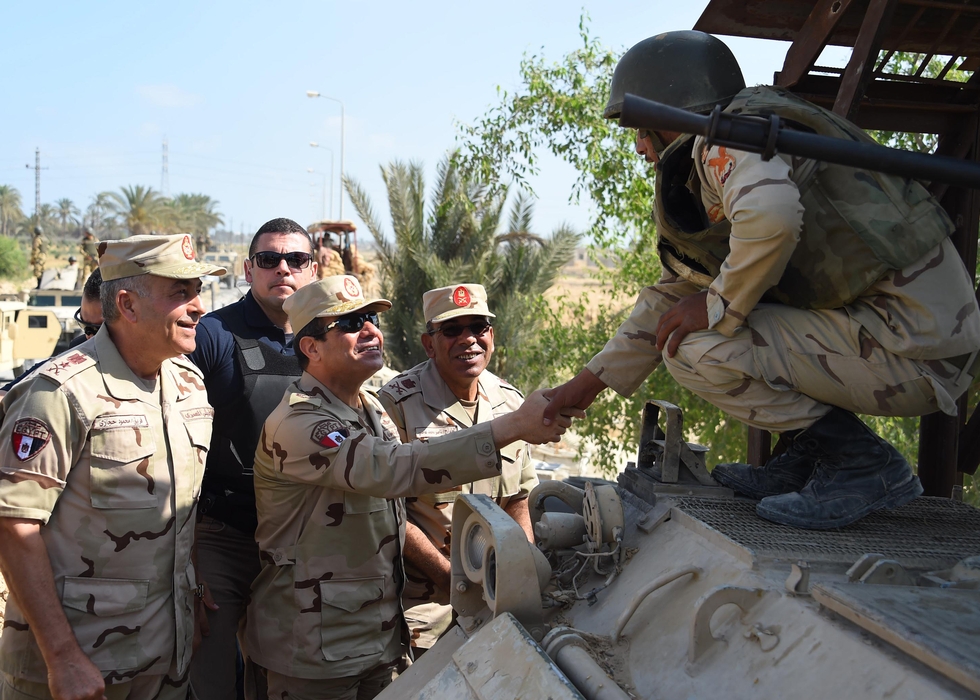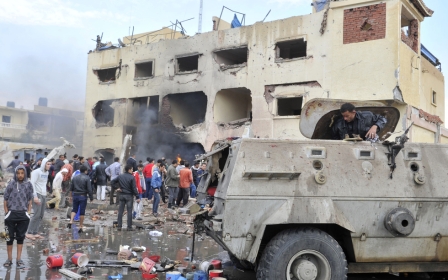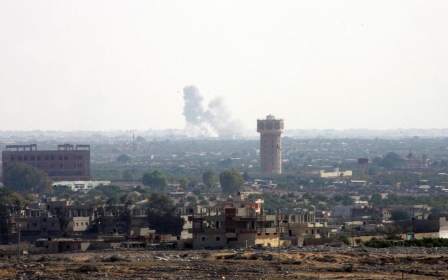Sinai’s tragedy: Between brutal repression and armed insurgency

“The Caliphate soldiers of Sinai Province [SP] have destroyed 44 kilograms of pure heroine, worth 13 million Egyptian Pounds [$1.3 million]. They executed the smuggler; a spy for the army in Shaybana village, south of Rafah City,” reported a statement with photographs issued by A‘maq News Network on 23 February 2016. The propaganda of A‘maq (one of the media affiliates of the Islamic State organisation) and the media office of Sina Province were not too far from reality.
SP, and its predecessors, have not only been able to endure five years of counterinsurgency campaigns, but have also been able to expand their geographical scope, tactical military capacity, operational intensity and durations, regional scale, quality of propaganda and communications, and existential legitimacy.
SP does not limit its activities to the military and security spheres. It has provided assistance to impoverished families whose houses were razed by the government forces, attacked smugglers of cigarettes and drugs and destroyed their containers, enforced checkpoints in the centres and suburbs of El-Arish, Sheikh Zuweid and Rafah, and more recently sent its affiliates to “advise” smokers of shisha in El-Arish cafes about health and morality.
Like other IS provinces, SP publishes its military metrics both monthly and annually. In January-February 2016 (corresponds to the Lunar month of Rabi‘ Thani in the 1437 Hijri year), SP issued its monthly “harvest of military operations,” declaring the alleged destruction of 25 armoured vehicles (including tanks, minesweepers, and bulldozers) and the alleged killing of over 100 soldiers, of which the army only acknowledged 28 in January 2016. According to SP, this was done via an overwhelming reliance on improvised explosive devices or IEDs (59 percent of the operations), followed by guerilla attacks (20 percent), and then by snipers (12 percent). The rest of the fatalities were due to close-quarter assassinations of commanders and informants (9 percent).
The Sinai insurgency has mutated significantly over the last 15 years, before the establishment of SP, and its predecessor Ansar Bayt al-Maqdis (Supporters of Jerusalem or ABM). It altered its purpose to controlling areas in northeast Sinai and attempting to defeat the regime’s security and military forces there. This is in addition to avenging the deaths that occurred during crackdowns by the regime’s forces in the aftermath of the July 2013 military coup, as well as weakening these forces in areas away from Sinai.
That military capacity and the mere ability to survive after about five years of military campaigns and security sweeps is puzzling for several reasons. Geographically, Sinai’s northeastern coastal terrain is not rugged. Most of the high mountains such as the peaks of Mount Catherine (8,668 feet) are in the south of the peninsula, far away from the bulk of the insurgency. El-Arish, Sheikh Zuweid and Rafah are mainly flat coastal districts on the Mediterranean, with a population of about 300,000.
Loyalty seems to be divided among this relatively small population. Almost every northeastern tribe and clan has members and supporters of the insurgency and supporters, informants and pro-regime armed tribesmen. The divisions do not follow clear rural-urban, settler-bedouin, tribal or administrative faultlines. Each of these categories has elements on both sides.
Finally, there is no state sponsorship for the insurgents. None of the regional governments are directly or systematically supportive of its elements, including the Hamas authorities in Gaza. On the other hand, the state’s military forces alone enjoy an estimated 500:1 manpower ratio, at the very least. This is in addition to the support provided by the United States in terms of financing, training, equipping and intelligence as well as the support provided by Israel in terms of intelligence sharing and tactical and operational coordination.
Causes of the insurgency
The insurgency, however, has survived for several reasons. They include the tactical and operational accumulative experiences and capacities of the insurgents since 2003, the mediocre and indiscriminately repressive counterinsurgency/counterterrorism policies of the state (since 1999), the socio-economic policies towards Sinai and its repercussions since the 1980s, the sociopolitical environment especially after the July 2013 coup, and the militarisation of regional politics, its sustained escalation and the resulting unstable sociopolitical environments.
The situation in Sinai is relevant to Europe for various known reasons, including the stability of the region, the 1979 Peace Agreement between Egypt and Israel, the security of the allies and countering terrorism andviolent extremism. Therefore, European governments should urge an overall policy change in North Sinai.
This should start from ending the negative stereotyping of Sinaians in the media. Sinai should not be dealt with as merely a geo-strategic security threat for Cairo. Parts of Sinai’s problem are further rooted in Egypt’s current crisis of national reconciliation, extremely polarised political environment, the absence of a non-violent conflict-resolution mechanism, the unprecedented brutality of the ruling regime’s policies towards dissent, the lack of security sector reform, and the structural deficiency in civil-military relations.
When it comes to Sinai, the latter deficiency is specifically related to the lack of oversight over national security policy formulation, its execution, in addition to the general lack of accountability when such policies fail or exacerbate a crisis.
A thorough revision of the military and security policies in Sinai has never happened. The only open discussion that occurred regarding Sinai was in the brief transition period between February 2011 and June 2013. It did not yield any executive policy and it died out quickly following the July coup.
This needs to change. In general, insurgencies do not pose a major threat to legitimate, well-institutionalised governments following competent counterinsurgency practices. This is not the case in Egypt where legitimacy is contested, institutions are corrupt, and the counterinsurgency practices have been brutal, immoral, illegal and ineffective at the same time.
Overall, failing counterinsurgency efforts will almost certainly require significant domestic reforms and policy changes in Egypt.
- Dr. Omar Ashour is a Senior Lecturer in Security Studies at the University of Exeter and an Associate Fellow at Chatham House in London. He the author of "The De-Radicalization of Jihadists: Transforming Armed Islamist Movements", and “Why Does the Islamic State Militarily Endure and Expand?” He can be reached at [email protected]
The views expressed in this article belong to the author and do not necessarily reflect the editorial policy of Middle East Eye.
Photo: Egyptian President Abdel Fattah al-Sisi (C) shaking hands with a member of the security forces during a visit to the Sinai Peninsula on 4 July, 2015 following a wave of deadly attacks on armed forces by militants who pledged allegiance to the Islamic State (AFP/ EGYPTIAN PRESIDENCY).
Middle East Eye propose une couverture et une analyse indépendantes et incomparables du Moyen-Orient, de l’Afrique du Nord et d’autres régions du monde. Pour en savoir plus sur la reprise de ce contenu et les frais qui s’appliquent, veuillez remplir ce formulaire [en anglais]. Pour en savoir plus sur MEE, cliquez ici [en anglais].





